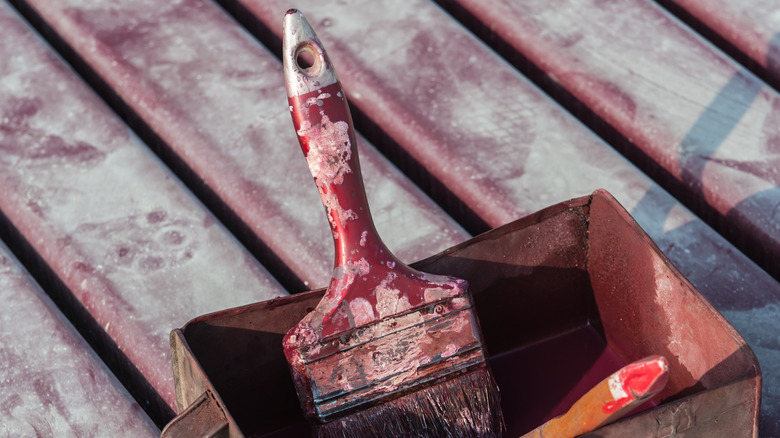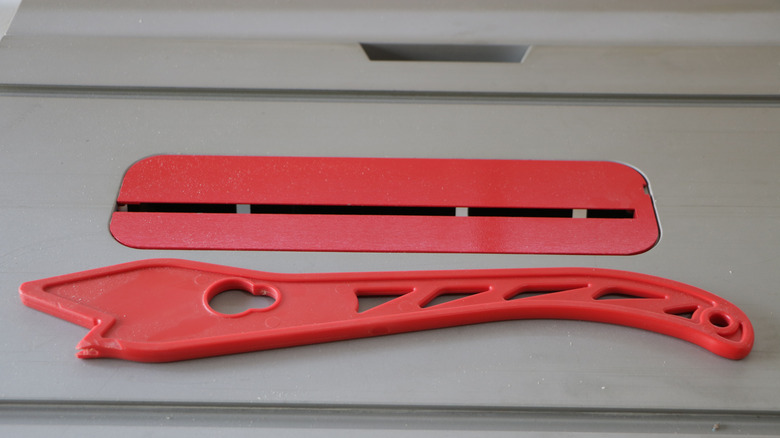Turn A Worn Out Paint Brush Into A Handy Push Stick With This Easy Hack
Painting is far more difficult when you're working with poor tools, and using a table saw is dangerous without the right tools. Someone figured out that the best use for a bad paint brush is to use it for something else — in this case, as a push stick to keep your hands well away from a spinning table saw blade. TikTok painting educator @idahopainter shows this hack in action in this simple video. He's using a wooden paintbrush handle, stripped of its bristles and metal ferrule, to push a board through his table saw while keeping his hand away from the blade. He's also using the saw's blade guard, an anti-kickback device known as a kickback pawl, and probably the saw's riving knife — the three safety devices that modern table saws come with by default.
In a study published in the journal Hand, the authors surveyed patients with table saw-related hand injuries and discovered that 73% of injured users were using a table saw with no safety devices enabled. But it's also telling that the 27% that were using at least one safety feature still sustained an injury worthy of a hospital visit. A push stick is a great way to drastically improve the safety of your table saw, whether or not you use the other safety features. And you should, in part because not all table saw injuries are hand injuries. Table saws are irreplaceable tools for anyone interested in woodworking at home, but they are dangerous.
Making the paintbrush push stick
@idahopainter appears to be simply using the wood handle from a paintbrush unmodified (other than removing the bristles and ferrule). This is simple enough to do with pliers and a bit of elbow grease. Art brush ferrules are typically crimped on, but the sorts of brushes you use to paint a wall also tend to have a few small tacks driven in to help hold the ferrule on. Find the seam in the metal ferrule and pry it apart with a screwdriver or your pliers, then pull the ferrule away from the handle from the loose end, working your way around. The tacks should come out fairly easily, but you can help them along with a tug from your pliers. Now you have @idahopainter's push stick, but we can do better.
The most common push stick design is basically a handle with a notch at the end. This notch is hooked on the end of the board you're pushing and provides both control and downward force when pushing the workpiece through the saw. Adding a notch to your paintbrush push stick can be done in a moment with almost any saw. The common push stick design has a notch with about a 110° "mouth," but to keep things simple, you can just make a 90° notch. The part of the notch that rests on top of your workpiece should be about a 30° angle to the tabletop.
Some other important considerations
Experienced woodworkers will have noticed the huge variety of push stick designs out there, from very simple DIY versions to Microjig's elaborate, adjustable pushblocks. Perhaps the most popular among experienced woodworkers has a very long face in contact with the top of the workpiece to apply downward pressure. You won't get this design from a paintbrush, but when choosing a paintbrush for a push stick, note that wide is better than narrow. And be sure to cut your notch so that you're getting as much surface area as possible on top of the workpiece.
One other note on paintbrush choice: Consider avoiding plastic- or composite-handled brushes for this purpose, and stick with wood instead. Many commercially available push sticks are made from plastic or even aluminum. Aluminum often provokes some negative reactions because of the obvious implications of having metal shards flying all around if you accidentally come into contact with the blade (and you eventually will). Hardened plastics can shatter when they come into contact with a blade, which can cause unpredictable and potentially tragic results. So unless you're familiar with the way your plastic paintbrush handle will react to a saw blade, it might be best to stick with wood and try to rescue that plastic paintbrush by using the vinegar trick to bring it back to life. And remember that a push stick can't save you from every accident, so check out our other tips for safely using a table saw.

